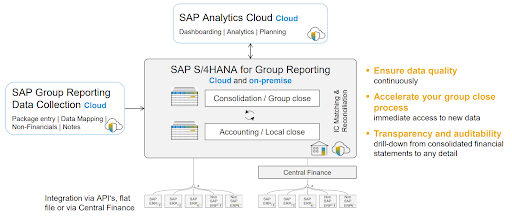What is the SAP Group Reporting Model?
Table of Contents
What are the Main Features?
Group Reporting + SAP Dimensions
SAP Group Reporting vs SAP BPC
How Do You Integrate SAP Group Reporting Into Your System?
What if I Need to Integrate Data that is Not in S/4HANA?
What if I am Already Using an Existing SAP Consolidation Solution?

SAP Group Reporting is an embedded solution in S/4HANA. This solution provides a live data connection so you can start the consolidation process with the latest entries made in S/4HANA. Because SAP Group Reporting is contained in SAP S/4HANA finance, there is no need for a master or transactional data replication and the associated maintenance.
Are you wondering “what is SAP Group Reporting going to do for my operations?” We can help. Let’s explore this solution in more detail.
What are the Main Features?
SAP S/4HANA Finance Group Reporting offers users many features for its consolidation process, such as:
- A “single version of truth” as it provides direct access to legal and management accounting from the Universal Journal, without requiring an ETL or data warehousing tool to transfer the financial records.
- It is fully aligned with SAP S/4HANA key concepts of real-time data access and minimizing data replication (both transactional and master data) and reconciliation. This provides a detailed perspective of the business at any point in time, speeding up the closing process and allowing more time to analyze and make business decisions.
- Group Reporting can be managed by the consolidation team without the need of technical support (including connection to S/4HANA Finance).
- Introduces Financial Statement (FS) Items, replacing the Group Chart of Accounts. The setup and maintenance of FS Items are managed inside Group Reporting, which means the Operating Chart of Accounts is not affected.
- Rule-based eliminations, validations, and reports by desired breakdown items are shared for both local and group closing activities.
- Fully enabled drill-down reporting to the entity line-items with ability to leverage all details contained within the Universal Journal. This is true for both transactional details and group (consolidation) entries including eliminations. This provides needed data transparency and auditability.
- SAP offers a clear roadmap for an integrated reporting platform that leverages SAP Disclosure Management for external and regulatory reporting with narratives and SAP Analytics Cloud for enhanced reporting and analysis.
- Users can drill from balances in Group Reporting back to the source journals in S/4HANA Finance.
- New innovative concepts leveraging the power of in-memory computing.

Group Reporting + SAP Dimensions
SAP S/4HANA Group Reporting consists in a new model that is made of several dimensions. These include the following:
- Consolidation Ledger
- Breakdown Categories
- Transaction Types
- Functional Areas
- Posting Level
- Document Type
- Partner Unit
- Version
- Cost Center
- Profit Center
- Selection
- Dimension
- Consolidation Methods
Each dimension is connected to master data in S/4, but there are dimensions which require manual maintenance directly in Group Reporting. These include FS Items, Consolidation Units, and Consolidation Groups. At all points of the consolidation process, master and transactional data quality checks are embedded to ensure alignment and accuracy.
SAP Group Reporting vs SAP BPC
Group Reporting in SAP is often preferred over SAP Business Planning and Consolidation (BPC). This is because it offers a significant advantage over any other consolidation solution on the market including the latter, as it eliminates the need for periodic data loads into a separate system.
How Do You Integrate SAP Group Reporting Into Your System?
When following Group Reporting installation best practices, the approach is to adopt client requirements to standard templates as all core functionality is available to start running the processes. This is our preferred and recommended approach. Through the engagement, we will register the Consolidation Units and Consolidation Groups, and we will also load the rates for currency conversion. At the same time, we take into consideration each entity’s specific accounting methods and requirements by leveraging the data and consolidation monitor.
What if I Need to Integrate Data that is Not in S/4HANA?

A common question clients have is if SAP Group Reporting can be leveraged in advance or in the absence of S/4HANA Finance. As it turns out, it can and is becoming a much more common approach as companies plan for their S/4 deployments. By leveraging Group Reporting data collection, we have the capability to consume data from legacy SAP ERP or non-SAP sources. Clients on the S/4HANA journey can consider this before deploying S/4.
What if I am Already Using an Existing SAP Consolidation Solution?
At Jump Analytics, as SAP Gold Certified partners, we can help you understand SAP Group Reporting, whether it is planning in a brand-new environment or in an existing S/4HANA landscape. To learn more or for assistance, reach out to us today.
